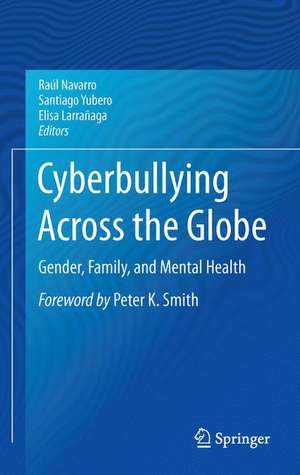Cyberbullying Across the Globe: Gender, Family, and Mental Health
Editat de Raúl Navarro, Santiago Yubero, Elisa Larrañagaen Limba Engleză Hardback – dec 2015
Included in the coverage:
• Gender issues and cyberbullying in children and adolescents: from gender differences to gender identity measures.
• Family relationships and cyberbullying.
• Examining the incremental impact of cyberbullying on outcomes over and above traditional bullying in North America.
• A review of cyberbullying and education issues in Latin America.
• Cyberbullying prevention from child and youth literature.
• Cyberbullying and restorative justice.
Cyberbullying across the Globe is an essential resource for researchers, graduate students, and other professionals in child and school psychology, public health, social work and counseling, educational policy, and family advocacy.
| Toate formatele și edițiile | Preț | Express |
|---|---|---|
| Paperback (1) | 640.37 lei 6-8 săpt. | |
| Springer International Publishing – 23 aug 2016 | 640.37 lei 6-8 săpt. | |
| Hardback (1) | 646.75 lei 6-8 săpt. | |
| Springer International Publishing – dec 2015 | 646.75 lei 6-8 săpt. |
Preț: 646.75 lei
Preț vechi: 760.88 lei
-15% Nou
Puncte Express: 970
Preț estimativ în valută:
123.77€ • 129.05$ • 102.86£
123.77€ • 129.05$ • 102.86£
Carte tipărită la comandă
Livrare economică 20 martie-03 aprilie
Preluare comenzi: 021 569.72.76
Specificații
ISBN-13: 9783319255507
ISBN-10: 3319255509
Pagini: 463
Ilustrații: XIV, 281 p.
Dimensiuni: 155 x 235 x 25 mm
Greutate: 0.59 kg
Ediția:1st ed. 2016
Editura: Springer International Publishing
Colecția Springer
Locul publicării:Cham, Switzerland
ISBN-10: 3319255509
Pagini: 463
Ilustrații: XIV, 281 p.
Dimensiuni: 155 x 235 x 25 mm
Greutate: 0.59 kg
Ediția:1st ed. 2016
Editura: Springer International Publishing
Colecția Springer
Locul publicării:Cham, Switzerland
Public țintă
ResearchCuprins
Foreword: An International Perspective on Cyberbullying; Peter K. Smith.- Chapter 1. Cyberbullying: Definitions and Facts from a Psychosocial Perspective; Anastasio Ovejero, Santiago Yubero, Elisa Larrañaga, María de la V Moral.- Part I. Gender, Family, and Psychosocial Issues.- Chapter 2. Gender Issues and Cyberbullying in Children and Adolescents: From Gender Differences to Gender Identity Measures; Raúl Navarro.- Chapter 3. Gender Variables and Cyberbullying in College Students; Elisa Larrañaga, Santiago Yubero, Anastasio Ovejero.- Chapter 4. Gender Differences and Cyberbullying Towards Faculty Members in Higher Education; Wanda Cassidy, Margaret Jackson, and Chantal Faucher.- Chapter 5. Family Relationships and Cyberbullying; Sofia Buelga, Belén Martínez-Ferrer and Gonzalo Musitu.- Part II. Global Research.- Chapter 6. Cyberbullying Matters: Examining the Incremental Impact of Cyberbullying on Outcomes over and above Traditional Bullying in North America; Gary Giumetti and Robin Kowalski.- Chapter 7. Cyberbullying and Education: A Review of Emergent Issues in Latin America Research; Fabiola Cabra Torres and Gloria Marciales.- Chapter 8. Cyberbullying in Eastern Countries: Focusing on South Korea and Other Eastern Cultures; Seung-ha Lee.- Chapter 9. Cyberbullying Research in Belgium: An Overview of Generated Insights and a Critical Assessment of the Medi
ation of Technology in a Web 2.0 World; Wannes Heirman, Michel Walrave, Heidi Vandebosch, Denis Wegge, Steven Eggermont, and Sara Pabian.- Chapter 10. Spanish Youth Perceptions about Cyberbullying: Qualitative Research into Understanding Cyberbullying and the Role that Parents Play in its Solution; Raúl Navarro and Cristina Serna.- Part III. Prevention and Intervention.- Chapter 11. Intervention and Prevention Programmes on Cyberbullying: A Review; Conor Mc Guckin and Lucie Corcoran.- Chapter 12. Cyberbullying and Restorative Justice; Susan Hanley Duncan.- Chapter 13. Reading and Texts: Cyberbullying Prevention from Child and Youth Literature; Santiago Yubero, Elisa Larrañaga, Sandra Sánchez, Cristina Cañamares.
ation of Technology in a Web 2.0 World; Wannes Heirman, Michel Walrave, Heidi Vandebosch, Denis Wegge, Steven Eggermont, and Sara Pabian.- Chapter 10. Spanish Youth Perceptions about Cyberbullying: Qualitative Research into Understanding Cyberbullying and the Role that Parents Play in its Solution; Raúl Navarro and Cristina Serna.- Part III. Prevention and Intervention.- Chapter 11. Intervention and Prevention Programmes on Cyberbullying: A Review; Conor Mc Guckin and Lucie Corcoran.- Chapter 12. Cyberbullying and Restorative Justice; Susan Hanley Duncan.- Chapter 13. Reading and Texts: Cyberbullying Prevention from Child and Youth Literature; Santiago Yubero, Elisa Larrañaga, Sandra Sánchez, Cristina Cañamares.
Notă biografică
Raúl Navarro, Ph.D., is a lecturer in the Department of Psychology at the University of Castilla-la Mancha, Spain. He received his Bachelor’s Degree in Education and Psychology from the University of Castilla-la Mancha, a Master’s Degree in Social Education from the University Pablo Olavide and his Ph.D in Psychology from the University of Castilla-La Mancha. Dr. Navarro’s research has focused on relationships among bullying behaviors and gender, aggression and school adjustment, online communication, antecedent factors of cyberbullying, and parental mediation and internet victimization. He has co-authored several book chapters on gender socialization and bullying, and has written articles about cyberbullying, which have been published in international journals. Dr. Navarro has given conferences and seminars with adolescents, teachers and parents about how to deal with bullying. He has been on research stays in Goldsmith College, London, with Peter K. Smith, Ph.D, and at the University of Massachusetts, Boston, with Martha Montero, Ph.D, to analyze bullying behaviors. He is currently teaching courses about social psychology, gender development and psychology values in the Social Education Degree and in the Master of Psychology.
Textul de pe ultima copertă
This book provides a much-needed analysis of the current research in the global epidemic of electronic bullying. Scholars and professionals from the Americas, Europe, and Asia offer data, insights, and solutions, acknowledging both the social psychology and technological contexts underlying cyberbullying phenomena. Contributors address questions that are just beginning to emerge as well as longstanding issues concerning family and gender dynamics, and provide evidence-based prevention and intervention strategies for school and home. The global nature of the book reflects not only the scope and severity of cyberbullying, but also the tenacity of efforts to control and eradicate the problem.
Included in the coverage:
• Gender issues and cyberbullying in children and adolescents: from gender differences to gender identity measures.
• Family relationships and cyberbullying.
• Examining the incremental impact of cyberbullying on outcomes over and above traditional bullying in North America.
• A review of cyberbullying and education issues in Latin America.
• Cyberbullying prevention from child and youth literature.
• Cyberbullying and restorative justice.
Cyberbullying across the Globe is an essential resource for researchers, graduate students, and other professionals in child and school psychology, public health, social work and counseling, educational policy, and family advocacy.Included in the coverage:
• Gender issues and cyberbullying in children and adolescents: from gender differences to gender identity measures.
• Family relationships and cyberbullying.
• Examining the incremental impact of cyberbullying on outcomes over and above traditional bullying in North America.
• A review of cyberbullying and education issues in Latin America.
• Cyberbullying prevention from child and youth literature.
• Cyberbullying and restorative justice.
Caracteristici
Synthesizes a broad base of international research on cyberbullying throughout childhood and adolescence Examines cultural similarities and differences in cyberbullying Explores the role of gender, family, and culture in cyberbullying incidents Analyzes the effects of cyberbullying across the developmental span from childhood to adolescence to young adulthood Discusses several global prevention and intervention programs? Includes supplementary material: sn.pub/extras











